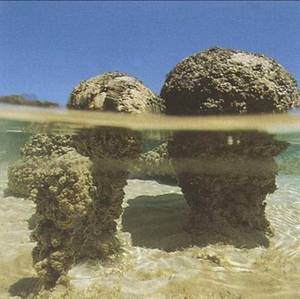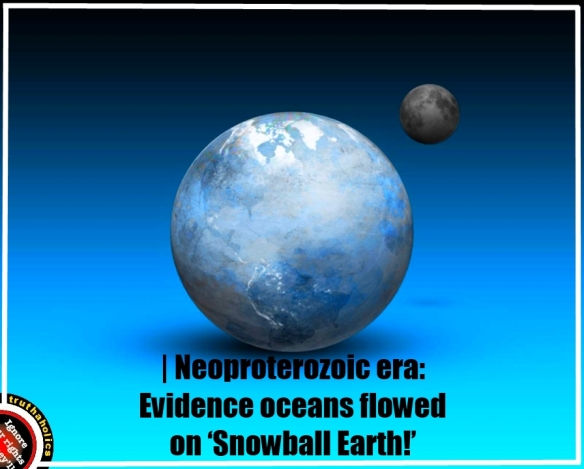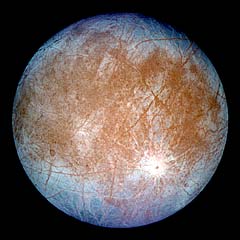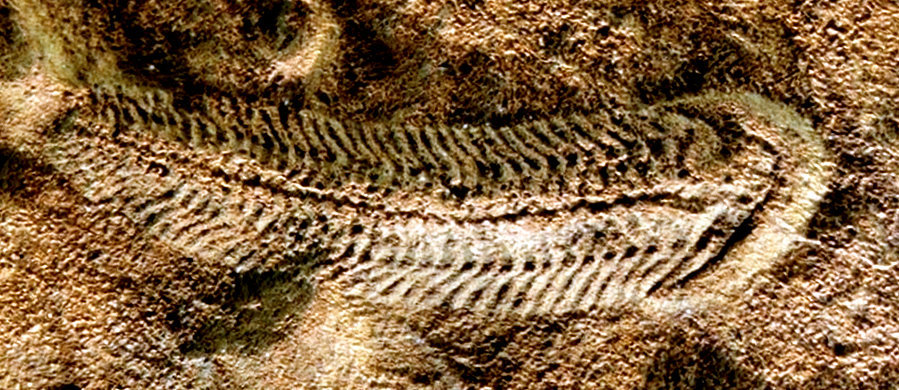Ediacaran seas [2]. They were descendants of the lucky survivors of global glaciation during the preceding geological era. Since the Ediacarian the global ocean stayed open and is prospering with life. However sea-life flourished since billion of years. Stromatolites populated freshwater of inland seas and coastal marine environments long time ago and still today. Different varieties of chlorophyta (green algae), bacteria and other unicellular marine algae, Acritarchs, prospered in the Proterozoic eon and were preserved as micro-fossil in marine sediments [3]. Many of these species were living on sulphur chemistry in an oxygen-poor sea through the billion years of the Proterozoic eon, including too a period that geologist like to call the "boring billion" [4], although certainly it was full of unknown adventures of evolution of life.
 |
| Cyanobacterial (Earth’s earliest oxygenic organisms) stromatolites from Sharks Bay, Australia |
Carbon isotope records in carbonate rocks and Neoproterozoic glacial deposits found in Namibia suggest that biological productivity in the surface ocean collapsed for millions of years. Thus life faced a dramatic bottleneck after nearly three billion years of evolution of multiple forms using either chemical process (chemotrophic) or light (phototrophic) as source of energy. Geological findings show that marine ice extended from the Poles to the Equator at least twice during the Neoproterozoic era.
It is a teasing question whether open water was found along the Equator during that periods. How would phototrophic life survive when the entire planet, land and seas, are covered by ice?
The kilometre-thick layer of ice of the Neoproterozoic
ice-age made Earth looking like Jupiter's icy moon Europa. "Snowball Earth" looked far different from the blue ball that fascinated so much the first astronauts. However the global ocean kept active under the global ice cover. Survival of phototrophic life in a Snowball Earth climate possibly depended, as outcome of a recent study [*] can be interpreted, on the ocean circulation and mixing processes
that kept local patches of water open and thus created "marine heavens" in which phototrophic life
could survive.
Ocean circulation and mixing processes set the melting and freezing rates of the "marine glaciers" today and in the Neoproterozoic era; the same physics apply. The melting and freezing rates determine ice-extend and the local ice thickness. Modern computer models of ocean circulation and ice-dynamics can simulate the physical behaviour of the global ocean of "Snowball Earth" and addressing too the question where to look for patches of open water for survival of phototrophic species.
The ocean of "Snowball Earth" was not freezing to the bottom. Salinity of seawater, high pressure and geothermal heat-flux from the bottom prevented that. The ocean is insulated at the surface from atmospheric forcing by the thick ice cover. This ice-cover also is a very good thermal isolator preventing heat loss from the ocean. These features make up the very particular ocean dynamics of "Snowball Earth". Water flows are driven by heat-flux from the sea-bottom and freezing at the surface. That is limiting vertical stratification. Today wind, radiation of the sun and evaporation drive the ocean currents from the surface and create a stable stratification of the water column. Geothermal heat-flux from the sea-bottom has not stopped, but its impact on the ocean dynamics is much less than the forces acting at the surface.
Ocean circulation and mixing processes set the melting and freezing rates of the "marine glaciers" today and in the Neoproterozoic era; the same physics apply. The melting and freezing rates determine ice-extend and the local ice thickness. Modern computer models of ocean circulation and ice-dynamics can simulate the physical behaviour of the global ocean of "Snowball Earth" and addressing too the question where to look for patches of open water for survival of phototrophic species.
 |
| from: http://truthaholics.wordpress.com/2013/03/06/ neoproterozoic-era-evidence-oceans-flowed- on-snowball-earth/ |
A recent study [*], modelling dynamics of the Neoproterozoic ocean, highlights the processes that could maintain spots of open water (or thin ice) that phototrophic forms of life need for survival at the ice-margin. Today marine life prospers at the margin of sea-ice because of the particular dynamics of ice water interactions. Likewise life dwells at the bottom of sea-ice as long as some light penetrates through the ice. It is a teasing hypotheses that similar "marine heavens" were found in the ice-covered Neoproterozoic ocean.
 |
| Modern Earth: Geothermal heat-flux |
The ocean temperature, salinity and density of Neoproterozoic ocean was fairly uniform in the vertical direction but showed lateral differences. These lateral differences of density sustained, because of the rotation of earth, jet-currents along the Equator. These currents were unstable and were shedding off eddies. These eddies transported warm water away from the Equator to the ice-margin. There the water was melting ice, was cooled, partly frozen to the ice, partly enriched in salt so that it sunk downward. A compensating upward flow of warm water occurred at the Equator to close the circulation cell. Ridges at the sea-bottom or continental margins brought the source of heat closer to the surface and were interacting with the equatorial jet-currents. This interaction caused local jets, eddies, coastal up-welling and down-welling as well as convective mixing . The weak stratification made up-welling and down-welling far easier to happen than today in our well stratified ocean. Thus "Snowball Earth" ocean was not a stagnant pool of cold water, it was highly dynamic; at least to the eye of the oceanographer.
And marine life? It survived "Snowball Earth". Both, the chemotrophic life that is using sulphur as source of energy and the phototrophic life that is using light as source of energy. Chemotrophic life would have survived in the depth of ocean under total ice-cover, but phototrophic life would have needed patches open surface water or thin ice; at least temporarily. The physics of ocean dynamics make it likely that these patches, "marine heavens" existed regularly in the ice-covered Neoproterozoic
equatorial seas.
An essential prerequisite for existence of these "marine heavens" is that geothermal heat-flux through the sea-bottom was bigger as heat loss through the layer of marine glaciers at the surface. This ice-layer was moved and cracked by tides (as for example satellite pictures from Jupiter's moon Europa show for its ice-cover) and therefore the very thick ice-layer was not a perfect isolator. Heat will have been lost through the ice-cover. Further studies of ice-dynamics may constrain what minimum geothermal heat-flux is needed to keep patches of the Neoproterozoic
ocean ice-free where ocean dynamics causes heat to be accumulated. Geophysical research
then
may assess whether this geothermal heat-flux is likely to have happened.
The end of Snowball Earth likely was caused by volcanism blowing carbon-dioxide into the very dry and cold atmosphere of that time [7]. Rain must have been seldom, and without rain little carbon-acid weathering of rocks occurs and no carbonates are flushed into the sea. Thus carbon-dioxide accumulates in the atmosphere building up a greenhouse effect that finally caused Earth to warm again.
If that scenario to end "Snowball Earth" happened, then Earth was saved
from staying frozen in snowball stage
by its active geophysical processes. To note the difference, Jupiter's moon Europa is frozen in snowball stage; likely the moon is too small for having an active geophysical evolution as planet Earth. However, researchers are quite certain that under the icy surface of moon Europa an ocean is alive. If it bears life we don't now. But if, then it will be of a chemotrophic form. Luckily survival of phototophic life on Earth in the global glaciations of the Neoproterozoic
era
has happened and likely
because ocean dynamics on a geophysical active planet with continents moving, plate-tectonics and a robust geothermal heat-flux created some "marine heavens".
 |
| The geochemical carbon cycle on a Snowball Earth http://www.learner.org/courses/envsci/unit/ text.php?unit=1&secNum=5 |
The end of Snowball Earth likely was caused by volcanism blowing carbon-dioxide into the very dry and cold atmosphere of that time [7]. Rain must have been seldom, and without rain little carbon-acid weathering of rocks occurs and no carbonates are flushed into the sea. Thus carbon-dioxide accumulates in the atmosphere building up a greenhouse effect that finally caused Earth to warm again.
 |
| see: http://www.seasky.org/ solar-system/jupiter-europa.html |
Martin.Mundusmaris@gmail.com
info@mundusmaris.org
info@mundusmaris.org
[*] Dynamics of a Snowball Earth ocean; Yosef Ashkenazy, Hezi Gildor, Martin Losch, Francis A. Macdonald, Daniel P. Schrag & Eli Tziperman; Nature 495, 90–93, 7th March 2013 March 2013
[1] for a debate about life on land see: http://www.nature.com/nature/journal/v493/n7430/full/nature11777.html
[2] from Wikipedia (simplified): (a) The Ediacaran Period named after the Ediacara Hills of South Australia, is the last geological period of the Neoproterozoic Era and of the Proterozoic Eon, immediately preceding the Cambrian Period. Its status as an official geological period was ratified in 2004 by the International Union of Geological Sciences (IUGS). Although the Period takes its name from the Ediacara Hills where geologist Reg Sprigg first discovered fossils of the eponymous biota in 1946, the type section is located in the bed of the Enorama Creek within Brachina Gorge in the Flinders Ranges of South Australia, at 31°19′53.8″S 138°38′0.1″E. (b)
The Ediacara biota consisted of enigmatic tubular and frond-shaped, mostly sessile organisms. Trace fossils of these organisms have been found worldwide, and represent the earliest known complex multicellular organisms. The Ediacara biota radiated in an event called the Avalon Explosion, 575 million years ago, after the Earth had thawed from the Cryogenian period's extensive glaciation [and] disappeared contemporaneously with the rapid appearance of Cambrian biota [which] completely replaced the organisms that populated the Ediacaran fossil record.
[3] from Wikipedia (simplified) Acritarchs have been recovered from sediments deposited as long as 3.2 billion years ago, but at about 1 billion years ago they started to increase in abundance, diversity, size, complexity of shape and especially size and number of spines. Their populations crashed during the Snowball Earth episodes, when all or very nearly all of the Earth's surface was covered by ice or snow, but they proliferated in the Cambrian explosion and reached their highest diversity in the Paleozoic. The increased spininess 1 billion years ago possibly resulted from the need for defence against predators, especially predators large enough to swallow them or tear them apart. Other groups of small organisms from the Neoproterozoic era also show signs of anti-predator defences. Further evidence that acritarchs were subject to herbivory around this time comes from a consideration of taxon longevity. The abundance of planktonic organisms that evolved between 1,700 and 1,400 million years ago was limited by nutrient availability – a situation which limits the origination of new species because the existing organisms are so specialised to their niches, and no other niches are available for occupation. Approximately 1,000 million years ago, species longevity fell sharply, suggesting that predation pressure, probably by protist herbivores, became an important factor. Predation would have kept populations in check, meaning that some nutrients were left unused, and new niches were available for new species to occupy.
[4] http://discovermagazine.com/2011/evolution/23-what-happened-earth-boring-billion-years#.UUlcMzsWm0c
[5] from Wikipedia (simplified): The Neoproterozoic Era is the unit of geologic time from 1,000 to 541 million years ago. The terminal Era of the formal Proterozoic Eon (or the informal "Precambrian"), it is further subdivided into the Tonian, Cryogenian, and Ediacaran Periods. The most severe glaciation known in the geologic record occurred during the Cryogenian, when ice sheets reached the equator and formed a possible "Snowball Earth". The earliest fossils of multicellular life are found in the Ediacaran, including the earliest animals.
[6] from Wikipedia (modified): Coriolis force: A force exerted on a parcel of water (or any moving body) due to the rotation of the earth. This force causes a deflection of the body to the right in the northern hemisphere and to the left in the southern hemisphere.
[7] from http://essayweb.net/geology/timeline/neoproterozoic.shtml (modified): The snowball Earth scenario does not require glaciation of the continents . The ice cover on the oceans prevented water from evaporating, and therefore the climate must have been very dry. Lack of precipitation likely caused at least parts of continents to be bare rock, as ice was sublimated or flowed into the sea, and was not replaced due to the lack of precipitation. The commonly proposed scenario for the end of snowball Earth is through the accumulation of carbon dioxide. Volcanism produces carbon dioxide, which accumulates until it reaches a point where it triggers warming through its greenhouse effect. The ice sheets are melted rapidly and temperatures rise, perhaps reaching as high at 50 °C temporarily, before the carbon dioxide is removed from the atmosphere. There is strong evidence of such extreme rises in atmospheric carbon dioxide, in the form of cap carbonates.


No comments:
Post a Comment